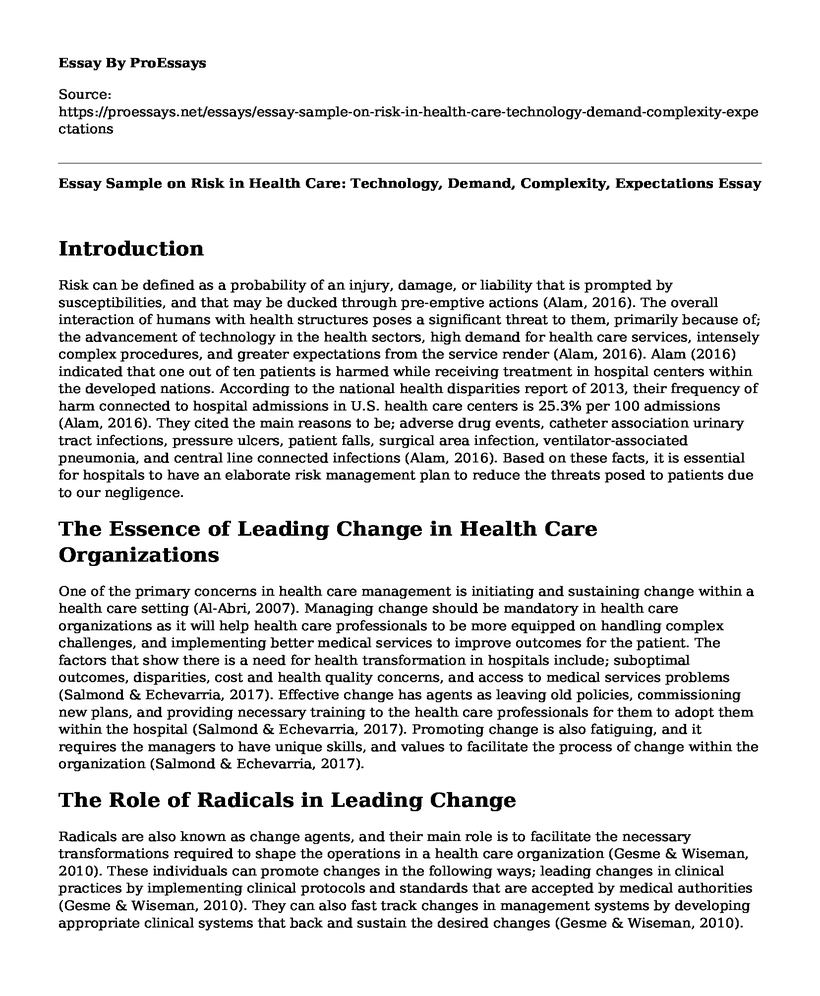Introduction
Risk can be defined as a probability of an injury, damage, or liability that is prompted by susceptibilities, and that may be ducked through pre-emptive actions (Alam, 2016). The overall interaction of humans with health structures poses a significant threat to them, primarily because of; the advancement of technology in the health sectors, high demand for health care services, intensely complex procedures, and greater expectations from the service render (Alam, 2016). Alam (2016) indicated that one out of ten patients is harmed while receiving treatment in hospital centers within the developed nations. According to the national health disparities report of 2013, their frequency of harm connected to hospital admissions in U.S. health care centers is 25.3% per 100 admissions (Alam, 2016). They cited the main reasons to be; adverse drug events, catheter association urinary tract infections, pressure ulcers, patient falls, surgical area infection, ventilator-associated pneumonia, and central line connected infections (Alam, 2016). Based on these facts, it is essential for hospitals to have an elaborate risk management plan to reduce the threats posed to patients due to our negligence.
The Essence of Leading Change in Health Care Organizations
One of the primary concerns in health care management is initiating and sustaining change within a health care setting (Al-Abri, 2007). Managing change should be mandatory in health care organizations as it will help health care professionals to be more equipped on handling complex challenges, and implementing better medical services to improve outcomes for the patient. The factors that show there is a need for health transformation in hospitals include; suboptimal outcomes, disparities, cost and health quality concerns, and access to medical services problems (Salmond & Echevarria, 2017). Effective change has agents as leaving old policies, commissioning new plans, and providing necessary training to the health care professionals for them to adopt them within the hospital (Salmond & Echevarria, 2017). Promoting change is also fatiguing, and it requires the managers to have unique skills, and values to facilitate the process of change within the organization (Salmond & Echevarria, 2017).
The Role of Radicals in Leading Change
Radicals are also known as change agents, and their main role is to facilitate the necessary transformations required to shape the operations in a health care organization (Gesme & Wiseman, 2010). These individuals can promote changes in the following ways; leading changes in clinical practices by implementing clinical protocols and standards that are accepted by medical authorities (Gesme & Wiseman, 2010). They can also fast track changes in management systems by developing appropriate clinical systems that back and sustain the desired changes (Gesme & Wiseman, 2010). Therefore, in any health organization there should be a dedicated change agent to lead the way, and motivate others into accepting the changes.
The Challenges of Opposing a Status Quo
Arnold Relman identified the need for improving patient outcomes as an element of change needed in the health care sector (Frater, 1992). However, the objective of the U.S. government was not to offer a rational basis for enhancing the efficacy of the health care system, neither was their goal on cost containment (Frater, 1992). Nevertheless, they wanted to focus on quality improvement, which means increased medical costs for patients seeking better medical services (Hickey & Brosnan, 2012). It would also challenge the status quo set by Arnold Relman on improving patient outcomes through cost containment. Therefore, the approach by the U.S. government seems more pragmatic, even though it has contravened the status quo (Frater, 1992). Because, the change we need in the health care setting is the quality enhancement in terms of error reduction more than cost containment (Frater, 1992).
Conclusion
In conclusion, the paper has provided an overarching analysis of the significance of having an elaborate risk management plan, the importance of leading change in health care organizations using the change agents (radicals), and the challenges of opposing the status quo. In a nutshell, one challenge of opposing the status quo will promote innovation and ideas being implemented, particularly in hospitals. Therefore, leaders must have the knack to think differently about how they can lead to positive changes in their respective health care organizations (Gesme & Wiseman, 2010).
References
Al-Abri, R. (2007). Managing change in healthcare. Oman medical journal, 22(3), 9. Retrieved from: https://www.ncbi.nlm.nih.gov/pmc/articles/PMC3294155/
Alam, A. Y. (2016). Steps in the process of risk management in healthcare. J Epid Prev Med, 2(2), 118. Retrieved from: file:///C:/Users/User/Downloads/StepsInTheProcessOfRiskManagement_AliYawarAlam_JEPM_Oct_2016.pdf
Frater, A. (1992). Health outcomes: a challenge to the status quo. Quality in Health Care, 1(2), 87. Retrieved from: https://www.ncbi.nlm.nih.gov/pmc/articles/PMC1054969/?page=1
Gesme, D., & Wiseman, M. (2010). How to implement change in practice. Journal of oncology practice, 6(5), 257. Retrieved from: https://www.ncbi.nlm.nih.gov/pmc/articles/PMC2936472/
Hickey, J. V., & Brosnan, C. A. (2012). Evaluation of health care quality in advanced practice nursing. Springer Publishing Company. Retrieved from: https://books.google.co.ke/books?hl=en&lr=&id=Tiv-oXHRwuAC&oi=fnd&pg=PR1&dq=The+importance+of+leading+change+in+healthcare+organizations+book&ots=4rRLEwyxuH&sig=2KSomvN6O_AU2ZEZfsHHgGdDw9Q&redir_esc=y#v=onepage&q&f=false
Salmond, S. W., & Echevarria, M. (2017). Healthcare transformation and changing roles for nursing. Orthopedic nursing, 36(1), 12. Retrieved from: https://www.ncbi.nlm.nih.gov/pmc/articles/PMC5266427/
Cite this page
Essay Sample on Risk in Health Care: Technology, Demand, Complexity, Expectations. (2023, Mar 27). Retrieved from https://proessays.net/essays/essay-sample-on-risk-in-health-care-technology-demand-complexity-expectations
If you are the original author of this essay and no longer wish to have it published on the ProEssays website, please click below to request its removal:
- Critical Thinking Example: Chapter 3 Reading Log
- The 2010 IOM Report on Nursing's Future and Its Impact Paper Example
- Difference Between E-Cigarettes and Traditional Cigarettes Paper Example
- Effect of Personality on Effective Nursing Leadership Paper Example
- Polycystic Ovarian Syndrome Paper Example
- Essay Example on Leadership: Crucial for People's Welfare and Quality of Life
- Free Paper Sample: HIV/AIDS Cases in Nigeria







